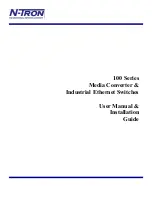
Page 186
Log Configuration
Figure 134. Log Configuration Page
Table 101.Log Configuration Fields
Click
Apply
to save any changes for the current boot session. The changes take effect immediately but
are not retained across a switch reset unless you click
Save Configuration
.
Field
Description
Buffered Log Configuration
Buffered Logging
Enables or disables logging system events to the buffered log. This feature is enabled by
default.
Severity Filter
Specify type of system messages logged using the Buffered Logging Level setting:
Emergency—Alerts the user of the highest level of system error classified as urgent.
Alert—Alerts the user of a high level of system error.
Critical—Alerts the user of a high level of system error which must be immediately
addressed.
Error—Alerts the user of an error in the system.
Warning—Warns the user of an impending system error of a specified operation.
Notice—Notifies the user of a system error.
Info—Provides the user with system information. This is the default filter level.
Debug—An internal note to reconcile programming code.
SysLog Configuration
SysLog Host
Enables and disables logging to configured syslog hosts. When the syslog admin mode is
disabled, the device does not relay logs to syslog hosts, and no messages are sent to any
collector/relay. When enabled, messages are sent to configured collectors/relays using the
values configured for each collector/relay. This feature is disabled by default.
UDP Port
The UDP port on the logging host to which syslog messages are sent. The port ID can be any
value from 1 to 65535. The default is 514.
IP Address
The IP address of the remote host to receive log messages.
Severity Filter
The severity level threshold for log messages. All log messages with a severity level at and
above the configured level are forwarded to the logging host. By default, messages
designated as Alert and higher are forwarded to the Syslog host.
















































